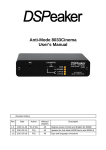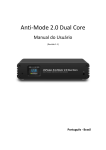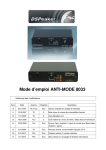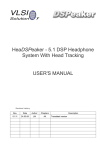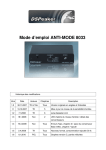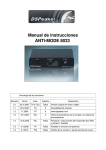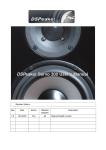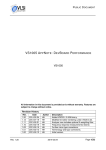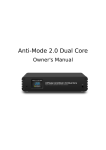Download DSPeaker Anti-Mode 8033S-II User`s manual
Transcript
Anti-Mode 8033 cinema Anti-Mode 8033S-II User's Manual Revision History Rev. Date Author Affected chapters Description 1.0 2007-11-30 TK & ToLi All Original version Finnish and English for 8033B 1.8 2012-02-15 POj All Updated for Anti-Mode 8033 cinema and 8033S-II 1.9 2012-03-18 POj All Typo and language corrections 2.0 2012-04-23 LMa All New layout, graphics Recycling information The product you have purchased is marked according to the Waste Electrical and Electronic Equipment Directive (WEEE Directive). There are take-back systems in place that help to preserve nature and natural resources when products are disposed of appropriately. If you need to dispose of this product, please use the take-back system that has dedicated collection facilities for electronic equipment. Do not put the product into household waste disposal! Also, the product has been manufactured using parts and processes that follow the directive of the Restriction of the use of certain Hazardous Substances in Electrical and Electronic Equipment (RoHS). Intended Use The product has been designed for normal indoor use and be connected to other equipment with cables not exceeding 3m (10 feet) in length. If you use cables of extended length, check that their quality is sufficient and observe electrostatic discharge precautions when connecting or disconnecting them. Use of the product outdoors, in humid or other extreme environments, may cause reduced performance and/or risks to the user of the equipment. ANTI-MODE 8033 CINEMA / 8033S-II Table of contents 1. Connections and Buttons.......................................................................................4 1.1. Front panel.........................................................................................................4 1.2. Back Panel.........................................................................................................5 2. Quick Setup Guide..................................................................................................6 2.1. Before Calibration..............................................................................................7 2.2. Calibration..........................................................................................................7 2.3. After Calibration..................................................................................................8 2.4. Subwoofer Placement........................................................................................9 2.5. Cross-Over Frequency.......................................................................................9 2.6. Multiple Subwoofers.........................................................................................10 3. Wider Area Correction..........................................................................................10 3.1. Strategy 1, “Compensation of the worst response point”................................11 3.2. Strategy 2, “Gradient compensation”...............................................................11 4. Basic operation.....................................................................................................12 4.1. Bypass mode...................................................................................................12 4.2. Lifting EQ.........................................................................................................12 4.2.1. Flat.................................................................................................................. 12 4.2.2. Lifting 15-25Hz................................................................................................12 4.2.3. Lifting 25-35Hz................................................................................................12 4.2.4. Subsonic Filter Only........................................................................................13 4.2.5. Lifting 20-30Hz (Anti-Mode 8033S-II)..............................................................13 4.3. Input Level Warning.........................................................................................13 4.4. Output Level Warning......................................................................................14 4.5. Powering Up and Down...................................................................................14 4.6. Low-pass Filter Selection (Anti-Mode 8033S-II)..............................................14 5. Connection Examples...........................................................................................17 6. Frequency Responses..........................................................................................18 6.1. Lift and Subsonic.............................................................................................18 6.2. Low-pass Filter Responses (Anti-Mode 8033S-II)...........................................19 6.3. Dipole Correction Responses (Anti-Mode 8033S-II).......................................19 7. Technical Specifications.......................................................................................20 8. Manufacturer..........................................................................................................20 9. Contact...................................................................................................................20 Rev. 2.0 18.06.2012 Page 3 (20) ANTI-MODE 8033 CINEMA / 8033S-II 1. Connections and Buttons 1.1. Front panel 1 2 3 4 5 6 7 1. Microphone input jack. 2. LIFT Button: LIFT25 / LIFT35 / FLAT selector. • Short press: Selects low frequency boost mode. • Long press (with bypass off): Stores current settings. • Long press (with bypass on): Enter filter selection mode (Anti-Mode 8033S-II). 3. BYPASS Button: BYPASS selector. • Short press: Toggle Bypass mode (disable / enable processing) • Long press: Begin secondary calibration for Wide Area Correction. • Long press of both LIFT and BYPASS buttons: Begin main calibration. 4. PWR LED: Lit when the device is on. • Flashes in filter edit mode, other LEDs show selected filter (Anti-Mode 8033S-II). 5. BYPASS LED: Lit when the Anti-Mode correction and lifts are bypassed. • Flickers for 3dB input level warning (if flickers constantly, please reduce input level) 6. LIFT25 LED: Lit when the 15-25Hz lifting EQ (equalization) and subsonic filter is on. • Is dimly lit along with the LIFT35 LED when the subsonic filter is active without lift. • Flashes during calibration. • Flickers for output saturation warning (please reduce input level). 7. LIFT35 LED: Lit when the 25-35Hz lifting EQ and subsonic filter is on. • Is dimly lit along with the LIFT25 LED when the subsonic filter is active without lift. • Flickers for input overdrive warning (please reduce input level). Level warnings create an irregular flickering of the respective LEDs. In calibration and low-pass filter selection mode the LEDs flash on and off in a steady pace. Anti-Mode 8033 cinema has yellow LEDs by default. Anti-Mode 8033S-II has blue LEDs by default. Rev. 2.0 18.06.2012 Page 4 (20) ANTI-MODE 8033 CINEMA / 8033S-II 1.2. Back Panel 1 3 2 Anti-Mode 8033 cinema Back Panel Anti-Mode 8033 cinema 1. 9 VAC / 12 VDC connector: Input power. 2. LINE OUT / RCA connector: To subwoofer. 3. LINE IN / RCA connector: LFE (Low-Frequency-Effects) or SUB (subwoofer) signal from the pre-amplifier or AVR (Audio/Video Receiver). 1 2 3 4 5 Anti-Mode 8033S-II Back Panel Anti-Mode 8033S-II 1. 9 VAC / 12 VDC connector: Input power. 2. OUT 180° connector: Inverted-phase RCA out. 3. OUT 0° connector: In-phase RCA out (to subwoofer, default) • A balanced XLR output can be created by combining the signals from the OUT 0° and OUT 180° connectors. 4. LEFT LINE IN / RCA connector: LFE or SUB signal from the pre-amplifier or AVR. 5. RIGHT LINE IN / RCA connector: LFE or SUB signal from the pre-amplifier or AVR. The dual LEFT / RIGHT inputs can be used to connect stereo systems that have only stereo preamplifier outputs instead of a single LFE output. You can also connect your home theater LFE output to the LEFT input and stereo system to the RIGHT input using an optional stereo to mono summing cable. Both Anti-Mode 8033 models can also be connected to speaker-level outputs using a power reduction device or a suitable resistor divider cable. Rev. 2.0 18.06.2012 Page 5 (20) ANTI-MODE 8033 CINEMA / 8033S-II 2. Quick Setup Guide 1. Please read the rest of the manual to get the most out of your system and the AntiMode 8033. 2. Connect the subwoofer signal to "LINE IN" (LEFT input on the 8033S-II). 3. Connect the active subwoofer to “LINE OUT” (or OUT 0°) output. 4. Connect the microphone plug to the "MIC" jack and place and fix the microphone as close to the listening position (head of the listener) as possible. Use of a microphone stand helps with correct microphone placement. 5. Connect the power supply to the "9 VAC / 12 VDC" connector and wall socket. 6. Anti-Mode 8033 will turn on automatically when you plug it in. 7. Note: All LEDs on the front panel are lit if the device has never been calibrated. 8. Switch on the subwoofer and moderately reduce its volume setting. 9. Press and hold both LIFT and BYPASS buttons for three seconds to start the first (main) calibration process. Release the buttons when the LIFT25 LED starts flashing. 10. If you keep holding the calibrate buttons down the calibration process will be aborted. Anti-Mode will generate up to 7 frequency sweeps (depending on the complexity of the correction required). The calibration process can last 15-30 minutes. When the LIFT25 LED stops flashing the calibration process is completed. For best results, run your AVR's calibration program to set speaker levels and distances after the Anti-Mode calibration has finished. Setting up Anti-Mode 8033 Rev. 2.0 18.06.2012 Page 6 (20) ANTI-MODE 8033 CINEMA / 8033S-II 2.1. Before Calibration If you have a small reflex subwoofer, decrease its volume before calibration. If the subwoofer has a built-in low-pass or other type of filter, it should be deactivated before the calibration process and re-activated after calibration. Cross-over and low-pass filters in the AVR do not affect calibration since they take place before the Anti-Mode 8033 in the signal chain. Also, any other audio equipment connected before the Anti-Mode 8033 will not interfere with the calibration process. Pay close attention to the vertical positioning (height) of the calibration microphone since proper room mode correction may be affected. The microphone is omnidirectional, so its precise orientation doesn't matter. If you use your subwoofer with doors closed, keep them closed during the calibration. If you want the room correction to affect a wider area, the first calibration point should be selected near the center of the listening area (or the primary listening position). More about Wider Area Correction in section 3. 2.2. Calibration If you have the Anti-Mode 8033S-II and a dipole (open-baffle) subwoofer, select the preferred dipole correction mode before starting the calibration. (See the section 4.6 on "Low-pass Filter Selection".) Press both the LIFT and BYPASS buttons on the front panel and hold them down to start the calibration process. Make sure that both of the buttons are pressed down at the same time. After a couple of seconds the LIFT25 LED starts flashing and calibration begins. Now release the buttons and wait for the automatic calibration to finish. The measurement program analyzes the room utilizing four to six frequency sweeps. The calibration starts with a moderate output volume. The measurement routine allows wide range of input levels. The input level warning LED (BYPASS LED) starts to flicker if less than 3.0 dB of headroom is left during measurement. If this persists the generated output level is adjusted down. If the microphone is near overflow, the sweep is restarted. The calibration process is very robust and it tolerates background noise very well, therefore speech and small noises do not affect the process. However, one should avoid making loud noises, especially near the microphone. For example, tapping the microphone or its cable can overflow the microphone input, causing the calibration process to restart. Tip: Tapping the microphone with a finger is an easy way to test the microphone, you will see the BYPASS LED flicker. A harder tap will restart the calibration process. Rev. 2.0 18.06.2012 Page 7 (20) ANTI-MODE 8033 CINEMA / 8033S-II If you initiate the calibration process by mistake, you can abort it by pressing either the LIFT or BYPASS buttons. This will restore your saved settings, including the lift settings (and other filter settings for the Anti-Mode 8033S-II). Calibration is automatically aborted after one sweep if the microphone is not connected properly, is faulty, or the calibration signal is not detected (for example, the subwoofer is not turned on). The previously saved settings are restored in this case. 2.3. After Calibration Once the last sweep is over, the calibration process is finished. The subsonic filter is automatically activated. The results are stored in the non-volatile memory inside the unit so they are not lost if the Anti-Mode loses power. Anti-Mode 8033 is now fully functional and the microphone can be detached, unless the user wishes to perform Wider Area Calibration. After calibration the subwoofer may sound more quiet. This is partly because the overall sound level decreases when the room resonances are suppressed, and in part, it just sounds more quiet because you have been used to peaks in the audio output. It may take a while to get accustomed to the new sound but you quickly start to notice sounds on frequencies that were drowned out by the untreated peaks. The calibration process raises the overall level, so the subwoofer volume needs to be increased only slightly (1-6 dB). For best results perform this adjustment using the AVR's subwoofer volume control. If the AVR supports speaker distances, you can add 90 cm (~36 inches) to the subwoofer distance relative to other speakers to compensate for the internal processing delay. This is not absolutely necessary since the delay is small enough that the human auditory system generally cannot detect it. You can also use your AVR's automatic calibration functions to determine the correct distance and level settings. In this case, the processing latency of the Anti-Mode and the new subwoofer level is automatically taken into account by the AVR and you do not need to adjust them yourself. Use the AVR's “small” speaker setting best results. First calibrate the Anti-Mode, then perform the AVR calibration so it sees the corrected response. Important! If only one sweep signal was generated during the calibration, one of the following situations occurred: the microphone was not properly connected, the calibration signal was not detected, or the calibration was aborted. If only two sweeps were generated, perhaps both buttons on the front panel were not pressed. In any case, the calibration process must be restarted. Rev. 2.0 18.06.2012 Page 8 (20) ANTI-MODE 8033 CINEMA / 8033S-II Whenever the placement of the subwoofer or listening position changes (or the dipole correction has changed in Anti-Mode 8033S-II), the initial calibration should be performed again to ensure an optimal result. 2.4. Subwoofer Placement There are several opinions available on how to determine the best place for your subwoofer. Due to room reflections creating resonances, some frequencies are amplified (room modes / peaks) and some are attenuated (nulls / dips). Without a sub EQ device, you need to locate the subwoofer in a place that creates the flattest possible response in your room. This is not what you want with Anti-Mode. With the Anti-Mode you do not need to be concerned about room modes because they are effectively corrected. Instead, you should concentrate on minimizing the number of nulls, because these cannot be corrected by a sub EQ device. If you are not happy with your subwoofer performance in its current location, try locating the subwoofer in a corner of the room. This causes the room modes to be excited maximally, but reduces the occurrence of nulls. The boundary reinforcement from the corner walls also allows the sub to reproduce lower frequencies without using extra power. Run the Anti-Mode calibration after relocating the subwoofer. Therefore, what was once considered the worst place to locate a sub is now the best place when using Anti-Mode! 2.5. Cross-Over Frequency The appropriate cross-over frequency to use depends on the capabilities of the subwoofer and main speakers. For best results, the main speakers should be set to 'small' in the AVR so only the subwoofer (whose response is corrected) is responsible for reproducing the low frequencies. With Anti-Mode the subwoofer integration through the AVR should be more effortless. You are now able to use a higher cross-over frequency than the standard 80Hz setting without the sub becoming localizable. We recommend trying 100Hz or 120Hz cross-over settin, but because there are varying differences between individuals, let your ears decide which setting is best for you. Rev. 2.0 18.06.2012 Page 9 (20) ANTI-MODE 8033 CINEMA / 8033S-II 2.6. Multiple Subwoofers Having multiple subwoofers reproducing the same signal (dual mono) will result in a smoother response. Anti-Mode can be used with any system allowing you to use corner placement of your subs. Connect the Anti-Mode to the signal going into each sub, and calibrate them together. When calibrated together, the nulls created by one sub are filled in by the other sub. Anti-Mode takes this into account, creating a smoother overall response than if the subs were calibrated separately. If you want to reproduce low frequencies in stereo, you need either two Anti-Mode 8033's or one Anti-Mode 2.0 Dual Core. Stereo at low frequencies is generally not needed, because low frequencies are omnidirectional and directional cues are determined from harmonics and other aural information. It is usually better to use the dual mono arrangement instead of stereo to get a more even response. 3. Wider Area Correction In some situations it is more favorable to compensate for room acoustics in a wider listening area. When this is done, the result is no longer optimal in any single listening position but is improved for a wider listening area. Before performing wider area correction the first (main) calibration procedure described in the earlier section must be performed. As previously discussed, the first calibration is done with the microphone at the center of the listening area or primary listening position within the area. The Anti-Mode 8033 can be calibrated for wider areas by moving the microphone to another point within the listening area. Pressing and holding the BYPASS button will initiate a secondary calibration utilizing two to three additional frequency sweeps. Anti-Mode 8033 will use the results from these sweeps in conjunction with data gathered from the first calibration to create a compensation model for a wider listening area. Do not accidentally keep both the LIFT and BYPASS buttons pressed on the front panel as this will start the first (main) calibration all over again overriding the current room data. Secondary calibrations can be done multiple times and will not result is the loss of data from the first (main) calibration. The previous secondary calibrations will not be retained. It is easy to try different secondary calibration points for the best audible result. Following are several strategies for choosing the microphone position for the secondary calibration. Rev. 2.0 18.06.2012 Page 10 (20) ANTI-MODE 8033 CINEMA / 8033S-II 3.1. Strategy 1, “Compensation of the worst response point” When the first (main) calibration is performed at the primary listening position or at the center of the listening area, you can then evaluate the result by listening at different positions around the room. If the result is not adequate at some location, that location can be used as a secondary calibration point. Also any location between the secondary point and the first point can lead to good results. Inevitably, the result will get less optimal at the first point, but is usually improved everywhere else, including the worst response point. 3.2. Strategy 2, “Gradient compensation” If it is difficult to find the worst response point in the listening area, Gradient compensation is a good approach. Find the secondary calibration point by moving the microphone from the first calibration point toward the closest corner of the listening room by 40-90 cm (16 to 36 inches) and downwards (towards the floor) approximately 10-20 cm (4 to 8 inches). Perform the secondary calibration with the microphone in this position. If the first calibration point was closer than a meter (39 inches) from the wall, the microphone should be moved only about 20-40 cm (8 to 16 inches) towards that wall for the secondary calibration. The Gradient compensation method works well in removing the resonances arising from reflections between opposing walls or floor/ceiling (axial modes) for larger areas in a rectangular room. Rev. 2.0 18.06.2012 Page 11 (20) ANTI-MODE 8033 CINEMA / 8033S-II 4. Basic operation 4.1. Bypass mode PWR BYPASS LIFT 25 LIFT 35 If you want to compare the corrected and uncorrected operation, press the BYPASS button quickly. This will switch between bypass and normal mode. The first press will put Anti-Mode into bypass mode, which is also indicated by the BYPASS LED being lit. If the Bypass mode is already active, the unit switches back to normal mode. In bypass mode no room corrections are active and user selected lifting EQ is turned off. Low-pass or dipole corrections remain active in bypass mode (8033S-II only). 4.2. Lifting EQ The LIFT button switches between the EQ settings of Anti-Mode 8033. The settings are stored with a longer press of the LIFT button. A brief sound heard from the subwoofer after settings have been stored indicates that you should release the LIFT button. 4.2.1. Flat PWR BYPASS LIFT 25 LIFT 35 The first EQ setting is “flat” or no lifting. Neither the LIFT25 nor LIFT35 LED are lit. In this setting, the target response is flat from 5Hz to 160Hz (8033 cinema) or 250Hz (8033S-II). This setting is automatically changed to Subsonic-Filter-Only after the first (main) calibration. You can override this and save the new setting. 4.2.2. Lifting 15-25Hz PWR BYPASS LIFT 25 LIFT 35 The second EQ setting is LIFT25. When the LIFT25 LED is lit, Anti-Mode boosts frequencies between 15 and 25Hz (max. 8dB at 20Hz). This will also activate a digital infrasonic filter, which will filter out frequencies below 10Hz, which can be dangerous to ported subs without proper protection. 4.2.3. Lifting 25-35Hz PWR BYPASS LIFT 25 LIFT 35 Rev. 2.0 The third EQ setting is LIFT35. When LIFT35 LED is lit, Anti-Mode boosts frequencies between 25-35Hz (max. 8dB at 30Hz). As with LIFT25, the digital infrasonic filter is also activated. 18.06.2012 Page 12 (20) ANTI-MODE 8033 CINEMA / 8033S-II 4.2.4. Subsonic Filter Only PWR BYPASS LIFT 25 LIFT 35 A fourth EQ setting activates the digital subsonic filter without any lift. The SubsonicFilter-Only mode is active when the LIFT25 and LIFT35 LEDs are dimly lit. The “flat” setting is automatically changed to this setting after the first (main) calibration. 4.2.5. Lifting 20-30Hz (Anti-Mode 8033S-II) PWR BYPASS LIFT 25 LIFT 35 The Anti-Mode 8033S-II has an additional EQ setting. Quickly press the LIFT button until both LIFT25 and LIFT35 LEDs are fully lit. This mode gives about 8dB of lift at 25Hz. The digital infrasonic filter is also activated. All lifting modes decrease the overall level of the signal by 3 dB to reduce the risk of clipping / saturating the output signal. Listening tells you which one of the lifting settings gives best results. The 'flat' and 'subsonic-filter-only' settings are probably the best options for music, because they give the most accurate transient response. Lift modes are not recommended when the dipole correction is active. 4.3. Input Level Warning If the input signal level in the Anti-Mode 8033's Analog to Digital Converter (ADC) is near the maximum input range, the user is warned in two phases. If the input signal level has only 3 dB of headroom remaining, the BYPASS LED will start flickering. If the level increases from this, the signal starts to saturate at the ADC input and harmonic distortion increases. If the input level reaches maximum, the LIFT35 LED starts flashing. When the input level is reduced the LEDs resume normal operation. The input level warning is useful in optimizing the signal level that goes into the Anti-Mode. If the volume of your subwoofer is too high, the AVR's calibration may set unnecessarily low levels for the subwoofer output. This leaves much of the Anti-Mode's available input range unused and can cause an audible low level hum or noise from the subwoofer. This may be the case if your AVR indicates its subwoofer output level is below -3dB. To take advantage of the full input range of the Anti-Mode, decrease the subwoofer volume and increase the output level from the pre-amplifier or AVR until you see only occasional 3dB warnings, then lower the volume a few dB. Rev. 2.0 18.06.2012 Page 13 (20) ANTI-MODE 8033 CINEMA / 8033S-II The level warning is also active during calibration. During calibration the output level is decreased automatically if needed (microphone is saturated). The LIFT25 LED flashes to indicate the progress of calibration. 4.4. Output Level Warning The new Anti-Mode correction will raise the overall level of the output depending on how drastic corrections were applied. This increase and an active lift mode can increase the output level in some frequencies so much that the signal gets saturated in the output. In this case the LIFT25 LED starts to flicker, and you should decrease the Anti-Mode 8033 input level or turn off lift mode. 4.5. Powering Up and Down Anti-Mode 8033 cinema and Anti-Mode 8033S-II have almost no power-on and power-off transients, so you can easily power them on and off using a switchable power cord or the switchable power output from your AVR. Anti-Mode also fades in when the signal starts, so it can be powered on without transients even while the audio signal is already applied to the input connector(s). Because the Anti-Mode consumes very little power, you may choose to leave it powered on. 4.6. Low-pass Filter Selection (Anti-Mode 8033S-II) Anti-Mode 8033S-II allows you to select additional filters that remain active while in bypass mode. Activate Neutral mode if you want to disable low-pass or dipole correction modes. The low-pass filters are useful when the main speakers cannot reproduce very low frequencies and the system does not have an adjustable cross-over. You can then select the suitable low-pass frequency to match the natural roll-off point of the main speakers. Dipole (open-baffle) subwoofers have a natural roll-off of 6dB per octave. If the subwoofer does not already have a correction circuit to counteract this, the bass will be lacking when the lower frequencies are reproduced. The dipole correction modes are designed to provide the necessary 6dB/octave boost to the lower frequencies. Because the dipole correction boost is also active during calibration (the lift modes are not), the Anti-Mode correction will work as it was intended and does not unnecessarily attenuate the higher bass frequencies when it tries to even out the response. Rev. 2.0 18.06.2012 Page 14 (20) ANTI-MODE 8033 CINEMA / 8033S-II The filter selection mode is activated as follows. Activate bypass mode by pressing the BYPASS button. 1. Keep the LIFT button pressed until the power LED starts to flash, indicating filter selection mode. 2. A quick press of the LIFT button selects between the neutral mode and one of the 7 filter modes. The selected filter is immediately activated. 3. Keep the LIFT button pressed to save the filter selection. A short beep is heard after settings are saved and the filter selection mode has ended. Release the LIFT button. 4. Quickly pressing the BYPASS button in filter select mode returns the unit to normal mode, with the selected filter and bypass mode activated. If you now press and hold the LIFT button, the lift and filter setting will be saved. Rev. 2.0 18.06.2012 Page 15 (20) ANTI-MODE 8033 CINEMA / 8033S-II LED indicators for filter modes (PWR LED flashes) PWR BYPASS LIFT 25 LIFT 35 PWR BYPASS LIFT 25 LIFT 35 PWR BYPASS LIFT 25 LIFT 35 PWR BYPASS LIFT 25 LIFT 35 PWR BYPASS LIFT 25 LIFT 35 PWR BYPASS LIFT 25 LIFT 35 (OFF) BYPASS Neutral mode Low-pass 60 Hz (-3 dB), 3rd order, 18 dB / octave Low-pass 80 Hz (-3 dB), 3rd order, 18 dB / octave LIFT25 BYPASS LIFT25 Low-pass 100 Hz (-3 dB), 3rd order, 18 dB / octave Low-pass 120 Hz (-3 dB), 3rd order, 18 dB / octave LIFT35 BYPASS Low-pass 140 Hz (-3 dB), 3rd order, 18 dB / octave LIFT35 Dipole correction 20–140 Hz, 6 dB slope, with infrasonic PWR BYPASS LIFT 25 LIFT 35 LIFT25 LIFT35 PWR BYPASS LIFT 25 LIFT 35 BYPASS LIFT25 LIFT35 Dipole correction 20–200 Hz, 6 dB slope, with infrasonic If you are going to use the dipole modes with your subwoofer, activate and save the filter setting before Anti-Mode calibration. The dipole correction filters are active during calibration to correct the open-baffle subwoofer's natural attenuation of bass in the lower frequencies. Other modes do not affect calibration and can be activated and deactivated at any time. Note: The calibration process always sweeps the entire 16-250Hz (Anti-Mode 8033S-II) range regardless of the filter selection. Rev. 2.0 18.06.2012 Page 16 (20) ANTI-MODE 8033 CINEMA / 8033S-II 5. Connection Examples In a basic home cinema configuration, the Anti-Mode 8033 cinema or the 8033S-II is connected between the AVR / pre-amplifier and the subwoofer using line-level connections. The dual line inputs of Anti-Mode 8033S-II are used when connecting into a 2.1 stereo system which has only stereo preouts available (no dedicated LFE or sub output). Anti-Mode 8033 cinema can be used, but it requires an additional stereo to mono converter cable. The dual line inputs of the Anti-Mode 8033S-II also allows you to connect both a home theater and stereo system at the same time. An additional stereo-to-mono converter cable is required. Two or more subwoofers can be connected using a splitter Y-cable, or by using the inverted-phase output of the 8033S-II and inverting phase on the subs connected to it. See more connection www.dspeaker.com . Rev. 2.0 18.06.2012 examples at Page 17 (20) ANTI-MODE 8033 CINEMA / 8033S-II 6. Frequency Responses 6.1. Lift and Subsonic Anti-Mode 8033 cinema (from left to right) Black: Bypass Red: Lift 15-25 Blue: Lift 25-35 Green: Subsonic Anti-Mode 8033S-II (from left to right) Black: Bypass Red: Lift 15-25 Magenta: Lift 20-30 Blue: Lift 25-35 Green: Subsonic Rev. 2.0 18.06.2012 Page 18 (20) ANTI-MODE 8033 CINEMA / 8033S-II 6.2. Low-pass Filter Responses (Anti-Mode 8033S-II) Anti-Mode 8033S-II low-pass (from left to right) Red: 60 Hz Green: 80 Hz Blue: 100 Hz Magenta: 120 Hz Yellow:140 Hz Black: Neutral The filters are 3rd order lowpass with -3dB point at the nominal frequency and with 18 dB / octave suppression. 6.3. Dipole Correction Responses (Anti-Mode 8033S-II) Anti-Mode 8033S-II dipole correction responses (from right to left) Black: Neutral Blue: 200 Hz Red: 140 Hz Note: These are not target or house curves. The dipole correction acts first to compensate the natural 6dB / octave roll-off of a dipole subwoofer. This pre-adjusted response is then measured and straightened by the AntiMode algorithm. Rev. 2.0 18.06.2012 Page 19 (20) ANTI-MODE 8033 CINEMA / 8033S-II 7. Technical Specifications Electrical characteristics: Power consumption: 1.2 W Input sensitivity: Line level (1.0 Vrms nominal, 1.75 Vrms max) Amplification: 3.0 dB (bypass) Operation voltage: 9 VAC or 12 VDC Low-pass (analog): Bessel 12 dB / octave, Q ~ 0.5, fc = 250 Hz 8033 cinema 8033S-II Frequency range (-3 dB): 5 – 160 Hz 5 – 250 Hz Dynamic ratio (unweighted): > 90 dB > 92dB Firmware features: Frequency resolution: < 0.5 Hz Maximum attenuation: 96 dB Filter Q-value range: Unlimited (32-bit integer space) Sub-sonic filter: 10 Hz (user-selectable) Computation accuracy: 32 / 40-bit integer Latency: 2.7 ms 8033 cinema 8033S-II Anti-Mode-Filters: 28 36 Correction range: 16 – 160 Hz 16 – 250Hz Lift filters: 20Hz, 30Hz 20Hz, 25Hz, 30Hz Lowpass filters: - 7 selectable modes 8. Manufacturer VLSI Solution / DSPeaker Division Hermiankatu 8 B FIN-33720 Tampere FINLAND Fax: +358-3-3140-8288 Tel: +358-3-3140-8200 Email: [email protected] 9. Contact Website: http://www.dspeaker.com/ Technical Support: [email protected] Product Information: [email protected] Rev. 2.0 18.06.2012 Page 20 (20)




















